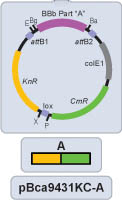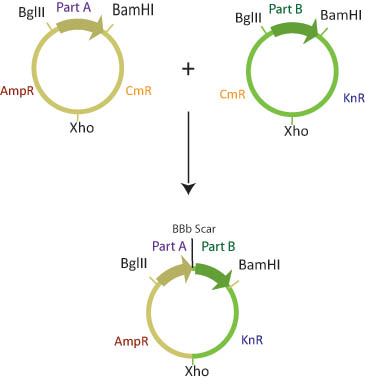Team:UC Berkeley/Assembly
From 2008.igem.org
ChrisBrown (Talk | contribs) |
ChrisBrown (Talk | contribs) (→Assembly Layer) |
||
| Line 5: | Line 5: | ||
The six assembly plasmids contain two of three different antibiotic resistance markers (kanamycin, ampilicin and Chloramphenicol) separated by a XhoI restriction site. The basic parts are flanked by BglII and BamHI restriction sites | The six assembly plasmids contain two of three different antibiotic resistance markers (kanamycin, ampilicin and Chloramphenicol) separated by a XhoI restriction site. The basic parts are flanked by BglII and BamHI restriction sites | ||
| - | [[assemblyplasmid.jpg]] | + | [[Image:assemblyplasmid.jpg]] |
The choice of antibiotic resistance markers in the assembly plasmids is predetermined such that once the two plasmids recombine, the new plasmid will have a combination of markers from the two assembly vectors. Although there are four possible products of this reaction, only one will have both of the correct antibiotic resistance markers. | The choice of antibiotic resistance markers in the assembly plasmids is predetermined such that once the two plasmids recombine, the new plasmid will have a combination of markers from the two assembly vectors. Although there are four possible products of this reaction, only one will have both of the correct antibiotic resistance markers. | ||
Revision as of 05:06, 28 October 2008
Assembly Layer
The six assembly plasmids contain two of three different antibiotic resistance markers (kanamycin, ampilicin and Chloramphenicol) separated by a XhoI restriction site. The basic parts are flanked by BglII and BamHI restriction sites
The choice of antibiotic resistance markers in the assembly plasmids is predetermined such that once the two plasmids recombine, the new plasmid will have a combination of markers from the two assembly vectors. Although there are four possible products of this reaction, only one will have both of the correct antibiotic resistance markers.
The assembly plasmids are transformed into cells that are engineered to either methylate BamHI or BglII restriction sites. Part A is transformed into a "lefty" cell that is methylated on BglII restriction sites while Part B is transformed into a "righty" cell that is methylated on BamHI restriction sites.
Lefty cells are engineered to stably express ligase and the BglII restrictions enzyme and are methylated on BglII cut sites. Righty cells are engineered to stably express XhoI and BamHI restriction enzymes and are methylated on BamHI cut sites. These cells are co-transformed with a plasmid containing our lysis device.
In a single eppendorf tube, lefty and righty cells containing basic part DNA are lysed using our lysis device. Click here for more information.[[1]]
The basic part DNA, along with the restriction enzymes are released into solution. Since restriction enzymes will not cut methylated DNA, the restriction site BglII site in the lefty cell and the BamHI restriction site in the righty cell are blocked from digestion. The BamHI site in lefty and the BglII site in lefty, and the Xho sites in both plasmids will be cut. Ligase will join the xho sites and the BglII/BamHI complimentary sticky ends.
The assembly reaction can be repeated to combine a number of basic parts in a desired order.
Once the composite part is complete, it is transferred to a destination plasmid.
 "
"

